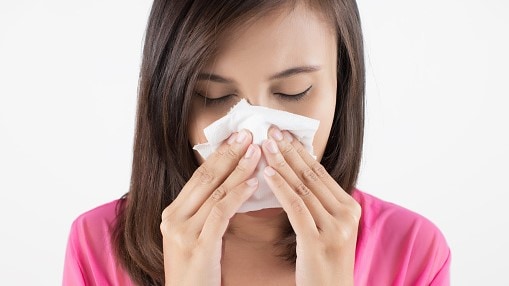At a glance
Research has found that people who spend time in damp buildings report health problems including respiratory symptoms and infections, developing or worsening asthma, hypersensitivity pneumonitis, allergic rhinitis or hay fever, and eczema (skin condition).

Allergies
Allergies or allergic responses to mold are common. In mold-allergic individuals, inhaling or touching mold may cause an allergic response, such as the following:
- Sneezing
- Nasal stuffiness or runny nose
- Red, itchy, or watery eyes
- Skin rash
Mold can also cause irritation of the eyes, nose, throat, skin, or lungs even in people who are not allergic to mold.
Asthma
Asthma is a lung disease that affects the airways in the lungs. Airways can become inflamed and narrowed at times. This makes it harder for air to flow out of the lungs when breathing out.
People with asthma may have one or more of the following symptoms:
- Coughing
- Wheezing
- Chest tightness
- Shortness of breath
Asthma is associated with exposure to irritants, allergens, and physical conditions (e.g., cold air) called triggers. Many asthma triggers can be in the workplace. Research shows evidence of an association between damp indoor spaces and asthma symptoms in individuals with pre-existing asthma.
This means exposure to molds in workplaces can make pre-existing asthma worse. There is also evidence of an association between damp indoor spaces and new-onset asthma.
Symptoms of work-related asthma tend to get better when away from work. However, in some cases, symptoms do not improve until an extended time away from the exposure or trigger. Workers who are already sensitized to mold may even respond to a trace amount of mold.
Diagnosing asthma is based on a combination of medical and exposure history, physician examination, and medical tests such as pulmonary function tests (e.g., spirometry and bronchodilator responsiveness testing). Workers may be able to use peak flow meters to link changes in lung function with environmental settings.
This is done by frequently measuring lung function multiple times a day at home and at work over several weeks. Recording these measurements may reveal a pattern of changing lung function and possible work relatedness.
Asthma takes ongoing monitoring and management to keep it under control. It is important for affected individuals to have a comprehensive asthma treatment plan and regular follow-up with their healthcare providers.
Hypersensitivity pneumonitis
Hypersensitivity pneumonitis is an immune system disorder. It causes the lungs to become inflamed in reaction to certain substances like:
- Inhaled bacteria
- Fungi
- Plant protiens
- Animal proteins
- Chemicals
It can seem like the flu or pneumonia, but hypersensitivity pneumonitis does not get better with antibiotics for infection.
Symptoms of this illness can vary. Some persons experience:
- Shortness of breath
- Cough
- Muscle aches
- Chills
- Fever
- Night sweats
- Extreme fatigue
- Weight loss
Symptoms may improve after a few hours or days when away from the substance or allergen causing illness. Likewise, hypersensitivity pneumonitis may be work-related if a worker's symptoms and medical tests (e.g., pulmonary function tests) improve when away from work and worsen when returning to work. With continued exposure, persistent lung inflammation over time could lead to permanent lung damage.
Hypersensitivity pneumonitis has been documented with workers in buildings with contaminated air-conditioners, ductwork, and filters. It has also occurred in workers in water-damaged buildings with roof leaks, plumbing leaks, or high indoor relative humidity.
- Arnow PM, Fink JN, Schlueter DP, Barboriak JJ, Mallison G, Said SI, Martin S, Unger GF, Scanlon G, Kurup VP [1978]. Early detection of hypersensitivity pneumonitis in office workers. Am J Med 64(2):236-242, https://doi.org/10.1016/0002-9343(78)90051-7.
- Banaszak EF, Thiede WH, Fink JN [1970]. Hypersensitivity pneumonitis due to contamination of an air conditioner. N Engl J Med 283(6):271-276, https://doi.org/10.1056/NEJM197008062830601.
- Bernstein RS, Sorenson WG, Barabrant D, Reaux C, Treitman RD [1983]. Exposures torespirable, airborne Penicillium from a contaminated ventilation system: Clinical, environmental and epidemiological aspects. Am Ind Hyg Assoc J 44(3):161-169, https://doi.org/10.1080/15298668391404581.
- Cox-Ganser JM, Rao CY, Park J-H, Schumpert JC, Kreiss K [2009]. Asthma and respiratory symptoms in hospital workers related to dampness and biological contaminants. Indoor Air 19(4):280–290, https://doi.org/10.1111/j.1600-0668.2009.00586.x
- Fink JN, Banaszak EF, Baroriak JJ, Hensley GT, Kurup VP, Scanlon GT, Schlueter DP, SosmanAJ, Thiede WH, Unger GF [1976]. Interstitial lung disease due to contamination of forced air systems. Ann Intern Med 84(4):406-413, https://doi.org/10.7326/0003-4819-84-4-406.
- Hoffman RE, Wood RC, Kreiss K [1993]. Building-related asthma in Denver office workers. Am J Public Health 83(1):89-93, https://doi.org/10.2105/AJPH.83.1.89.
- IOM [2004]. Damp Indoor Spaces and Health. Institute of Medicine, Washington, DC:National Academy of Sciences. https://doi.org/10.17226/11011.
- Mendell MJ, Mirer AG, Cheung K, Tong M, Douwes J [2011]. Respiratory and allergic health effects of dampness, mold and dampness-related agents: a review of the epidemiologic evidence. Environ Health Perspect 119(6):748-756, https://doi.org/10.1289/ehp.1002410.
- Park JH, Cox-Ganser JM [2011]. Mold exposure and respiratory health in damp indoor environments. Front Biosci (Elite Ed) 3(2):757-771, https://doi.org/10.2741/e284.
- Park J-H and Cox-Ganser JM [2022]. NIOSH dampness and mold assessment tool (DMAT): Documentation and data analysis of dampness and mold-related damage in buildings and its application. Buildings 12(8):1075, https://doi.org/10.3390/buildings12081075.
- Park J-H, Schleiff PL, Attfield MD, Cox-Ganser JM, Kreiss K [2004]. Building-related respiratory symptoms can be predicted with semi-quantitative indices of exposure to dampness and mold. Indoor Air 14(6):425–433. https://doi.org/10.1111/j.1600-0668.2004.00291.x
- Seuri M, Husman K, Kinnunen H, Reiman M, Kreus R, Kuronen P, Lehtomäki K, Paananen M. [2000] An outbreak of respiratory diseases among workers at a water-damaged building – a case report. Indoor Air 10(3):138-145, https://doi.org/10.1034/j.1600-0668.2000.010003138.x.
- Thörn A, Lewné M, Belin L [1996]. Allergic alveolitis in a school environment. Scan J Work Environ Health 22(4):311-314, https://doi.org/10.5271/sjweh.146.
- Weltermann BM, Hodgson M, Storey E, DeGraff AC, Bracker A, Groseclose S, Cole SR, Cartter M, Phillips D [1998]. Hypersensitivity pneumonitis: a sentinel event investigation in a wet building. Am J Ind Med 34(5):499-505, https://doi.org/10.1002/(sici)1097-0274(199811)34:5<499::aid-ajim11>3.0.co;2-x.
- WHO [2009]. WHO guidelines for indoor air quality: dampness and mould. World Health Organization, https://www.ncbi.nlm.nih.gov/books/NBK143941/.
